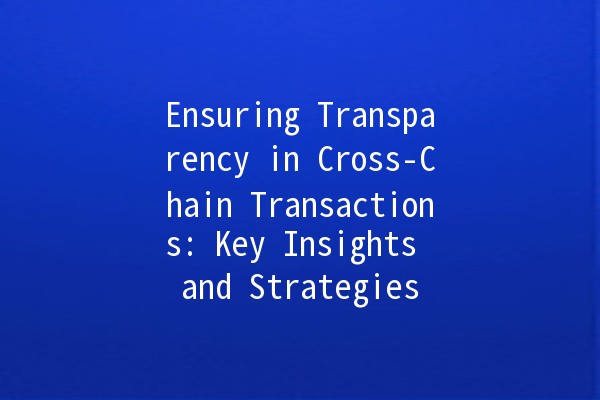




In recent years, the blockchain ecosystem has rapidly evolved, giving rise to an array of different networks, each with its own unique functionalities and capabilities. However, the fragmentation of these networks has led to challenges, particularly in executing transactions across different blockchains. Crosschain transactions, which enable the transfer of data and value between disparate blockchain systems, hold the promise of greater interoperability. Nonetheless, ensuring transparency in these transactions is essential for building trust among users and stakeholders.
This article delves into the nuances of transparency in crosschain transactions, outlining several strategies and techniques to enhance their visibility and integrity.

Transparency in crosschain transactions serves multiple purposes:
To ensure that crosschain transactions are transparent, here are five key techniques that can be implemented along with practical examples:
Explanation: Decentralized oracles act as intermediaries that provide external data to smart contracts on the blockchain. They verify and relay information about the status of crosschain transactions.
Application Example: Consider a scenario where a user wants to perform a transaction between Ethereum and Binance Smart Chain. A decentralized oracle could pull realtime price data for an asset from multiple exchanges, ensuring that the transaction reflects the true market value, thus enhancing transparency about the transaction’s parameters.
Explanation: Implementing public, auditable ledgers allows stakeholders to track and verify crosschain transactions in realtime.
Application Example: Projects like Polkadot and Cosmos leverage shared ledgers for crosschain transactions. By providing an auditable trail of previous transactions, users can assess the integrity of the crosschain transaction before participating, thereby increasing transparency.
Explanation: Smart contracts can automate crosschain transaction processes while embedding rules that require validation at various stages of the transaction.
Application Example: If a user is swapping tokens from one chain to another, a smart contract could be programmed to require confirmation from both chains before finalizing the transaction. This not only provides a verification mechanism but also assures users that both parties consent to the transaction, which increases transparency.
Explanation: Utilizing webbased monitoring tools that display realtime data about crosschain transactions can significantly enhance transparency.
Application Example: Platforms like Chainlink offer monitoring dashboards that provide insights into ongoing crosschain activities. Users can see pending transactions, transaction fees, and confirmations, thus ensuring that they remain informed throughout the process.
Explanation: Conducting routine security audits and offering comprehensive reporting on crosschain transaction processes significantly boosts transparency.
Application Example: A DeFi project could publish quarterly reports that summarize the performance and security of its crosschain operations. By providing stakeholders access to these audits, projects can reinforce their commitment to transparency and build trust within the community.
Q1: What makes crosschain transactions complex?
Crosschain transactions are complex due to the interoperability issues between different blockchain networks. Each blockchain has its own protocols, consensus mechanisms, and governance models, making it challenging to facilitate seamless transactions without a trusted intermediary. Additionally, security and trust issues arise because users often have to rely on external services to relay information between chains.
Q2: How do decentralized oracles improve transparency?
Decentralized oracles improve transparency by offering verifiable external data to smart contracts, enabling them to act based on realworld conditions. When multiple decentralized oracles provide the same data to a smart contract, they reduce the risk of manipulation and ensure that all parties involved can access accurate information, fostering a sense of trust.
Q3: Are there risks associated with transparency in crosschain transactions?
While transparency can reduce fraud, it can also present risks such as data exposure, where sensitive information might be inadvertently disclosed. Projects must strike a balance between providing visibility into transactions and maintaining user privacy. Additionally, malicious actors might exploit transparent data to manipulate market conditions, so security measures must be in place.
Q4: What role does blockchain technology play in ensuring transparency?
Blockchain technology inherently promotes transparency as it creates immutable records of transactions. Each transaction is timestamped and can be viewed by any user on the network. This transparency is crucial for crosschain transactions, as it allows users to verify the integrity of their transactions and ensures that all parties have access to the same information.
Q5: Can transparency in crosschain transactions impact regulatory compliance?
Yes, enhanced transparency in crosschain transactions can facilitate better compliance with regulatory requirements. Authorities typically favor systems that allow for the tracking and auditing of transactions, making it easier for companies to demonstrate compliance with antimoney laundering (AML) and knowyourcustomer (KYC) regulations.
Q6: What steps can blockchain projects take to promote transparency?
Blockchain projects can promote transparency by implementing audits, regular reporting, realtime monitoring tools, and by employing decentralized oracles. They can also foster community engagement by holding discussions and feedback sessions, which can help build trust and ensure stakeholders are informed about project developments.
Ensuring transparency in crosschain transactions is not merely beneficial; it is essential for fostering trust, preventing fraud, and ensuring regulatory compliance. By implementing the key techniques outlined above, projects can effectively enhance the visibility of their transactions, promoting a more robust and trustworthy blockchain ecosystem. Through the continued evolution of technology and practices, the dream of seamless crosschain transactions can become a reality, benefiting users and stakeholders alike.